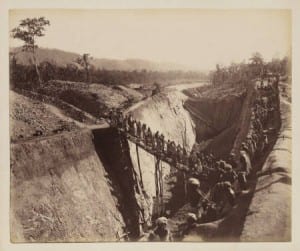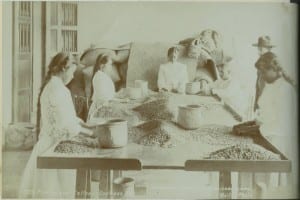Textual evidence may provide the necessary information and evidence to understand the situations of a time in history, but very rarely do they paint a vivid picture of the circumstance at hand. This is where visual sources play a crucial role. Photographs of history not only give you a visual experience but also a textual experience as well. The viewer is not only During the colonization of the two countries, building railroads were very key aspects into not only the growth of the country but also the wealth, this following article will take the reader on a textual journey of photographs taken in India and Mexico to see the growth of transportation that led to the infrastructure of transporting goods across the countries and also the problems that people had to face.
India’s Railroads
The first photo is a picture from India taken in the early 1980s, and is titled Bengal-Nagpur Railway Construction. This photograph gives a strong idea of how difficult it was in this era to not only build the railroads but it also lets the viewer see how important the railroads were to be for the future of the country. In the photo you can see hundreds of people around the valley working to get these railroads complete. You can also see how dangerous it was for people to build these railroads, the bridge that is going across the valley is very flimsy and only pieces of wood are holding it up, but yet there are about 20 people on it at once. Many conclusions can be taken from this photo but it is clear that the British wanted to get the railroads completed as quickly as possible so that they can start transporting goods all over the country. “In a country of continental distances, it [the Bengal-Nagpur Railway] provided the foundation for modern economic expansion by facilitating the carriage of huge quantities of passengers and freight over very long distances at hitherto unparalleled speeds”(BNR). The reason why the British wanted to colonize in India in the first place is because of the goods that the country had to offer, such as their textile goods. With the introduction of railroads across the country the British would be able to get certain goods from one point of the country to another quicker and more efficient but most importantly more money would be brought in from it. Because the British were the ones that wanted to start the construction of the railroads it is easy to conclude that that they made the Indians do the dirty work and the hard-manual labor while they watched over and told the Indians what to do. As you can see in the climate in which they work in seems very dry and the air seems hot, yet they Indians continue working.
Mexican Railroads
(Photo)Much like the railroads in India, the many railroads that were built in Mexico were to not only transport people and goods from one place to another, but also generate and bring in capital at a faster rate than it was before. “From the city of Chihuahua to a port in Sonora or northern Sinaloa, from the City of Mexico to the port in Guerrero, from Guadalajara to Mazatlan, From Tehuantepee line to Campeche, and from the City of Mexico to Tampico”(Powell). Although there are many more train routes than these in Mexico you can see a constant trend with the direction that the railroads were intended to go, and that was, out to the ports of the Pacific ocean and/or the Gulf of Mexico and back. “In 1911, Mexico had 24,717 kilometers of line built, today there are approximately 21,00 kilometers in operation Before the railroads were built in Mexico “the conveyance of all kinds of merchandise throughout the Republic of Mexico is effect by pack-mules and oxen. With the system, and the bad state of roads generally, it will be easily understood that transportation is not only slow but also costly, and forms one of the chief obstacles in the way of development of the great resources of the country. Railroads dramatically decreased transportation costs so that heavy or bulky products could be exported to Mexico’s Gulf Coast ports as well as rail links on the U.S. border. Railroads were initially owned almost exclusively by foreign investors, expanded from 1,000 kilometers to 19,000 kilometers of track between 1876 and 1910. The average distance performed by mules and wagons is from fifteen to 18 miles per day”(RRofM 93). Railroads dramatically decreased transportation costs so that heavy or bulky products could be exported to Mexico’s Gulf Coast ports as well as rail links on the U.S. border. Railroads were initially owned almost exclusively by foreign investors, expanded from 1,000 kilometers to 19,000 kilometers of track between 1876 and 1910. Railways have been termed a “critical agent of capitalist penetration By building these railroads and having them be a key point in society, the process of getting from one place to the other increases dramatically because early travelers in Mexico traveled upon backs of animals or in some instances in a heavy four-wheeled carriage called a (volante).
____________________________________________
India’s Worth
There are many factors that come into play when countries from Europe want to expand and colonize in different parts of the world. The land that the colonizers want to colonize must be able to bring in wealth. This is exactly why the British wanted to expand into South Asia. Prior to the British expanding into India, trade was a very big deal in the Indian Ocean. Even though trade was more common along the shores of India and down through Africa, there was also trade inland. In the Indian Ocean world there was a larger population than there was in the new world therefor a more chance to bring wealth for your empire and also to spread their religion and to serve god. With the Indian Ocean being the most used trading cycle in the world at the time India was known for having a lot of textiles and spices such as pepper, cinnamon, and cotton. “Among Indian handicrafts, the textile industry (especially cotton) was the most highly developed in terms of product differentiation” (Mukund 2058) In the picture above The Cotton Market, Bombay taken by photographer William Johnson, was taken to portray the every day life of a cotton picker in India. As the title of this picture portrays, the picture is of a market in the Indian city of Bombay selling cotton. Eight men, all wearing turbans, are seen sitting on and standing around numerous large bundles of cotton. In the photo there is also very large bags filled with cotton that these workers might have picked that morning. One man looks like he is stuffing a bag of cotton with a long stick, and others have bundles in their hands, possibly doing some sort of process that makes the cotton have less surface area making more room in the bag so that they can ship these off. Despite the mass of cotton around the men, none of them look wealthy. All are wearing simple white clothing, most likely cotton or even wool, with no color or intricate patterns that would symbolize wealth. This shows how the once booming cotton industry in India was crippled and taken over by the industrial textile factories of England. It is important to note that English letters can be seen on the large bundles of cotton in the background, showing that the cotton must have first came through the English, leaving less profit for the Indians pictured. Picking cotton is no easy job. It is very hard on the back and also the hands because the cotton plant is very sharp. Much like in today’s society the nicer the material is the more expensive it is going to be. Back then, it was the same concept, the rich had the nice material and the poor had the wool and sometimes cotton. To have silk meant that you were very wealthy and in a higher place in society.
___________________________________
Mexico’s Textiles through Railroads
The Next photo from Mexico is titled Picking over Coffee in Coatepec, and was taken by the photographer Charles Burlinghame as part of his Album of people and views of Mexico. In this photo that he took there is four women and one man that the viewer can clearly see. The four women appear to be sorting through the coffee beans and placing them into individual straw baskets situated in front of them on the table. These coffee beans could potentially be sol as they are or ground or ground up into a smaller form and then transported across the country or even across the ocean back into Europe. The man in the picture is probably a higher-ranking individual in the company and is in charge of supervising aspects of the harvesting and packaging of the coffee beans. He may also be the owner of the building or of the coffee farm that they bag the beans at. In the early 1900s in Mexico railroads were spreading like wild fire, creating an entire network of railways the covered most of Mexico if not all. The railroads were mainly built so that they could transport textiles from place to place and increase revenue. It was during this period when Porfirio Diaz took over in the 1900s implementing railroads when the money revenue began to increase over time. With “Mexico’s railroad development reaching its peak in 1910”(Coatsworth 941), the transportation of goods from Mexico to other countries and other parts of Mexico were at a all time high. With women like these four in the picture producing and packaging as much textiles as possible such as coffee beans shown above, cotton, steal, and even pottery objects, revenue would increase for the country of Mexico.
Works Cited Page
Coatsworth, John H. “Indispensable Railroads in a Backward Economy: The Case of Mexico.” The Journal of Economic History. Cambridge University Press, Dec. 1979. Web.
Kerr, Ian J. Engines of Change: The Railroads That Made India. Taylor & Francis Online. Routledge, 7 Apr. 2012. Web.
Mukund, Kanakalatha. “Indian Textile Industry in 17th and 18th Centuries: Structure, Organisation and Responses.” Economic and Political Weekly. Economic and Political Weekly, 19 Sept. 1992. Web.
Osgood, Hardy. The Revolution and the Railroads of Mexico. 3rd ed. Vol. 3. N.p.: U California, n.d. Print.
Powell, Fred Wilbur. The Railroads of Mexico. Boston: Stratford, 1921. Print.
“The Story of Bengal Nagpur Railway (BNR) Now South Eastern Railway.” Angloindiacentral RSS. Anglo-India-Central, 7 Feb. 2011. Web. 29 Apr. 2015.




